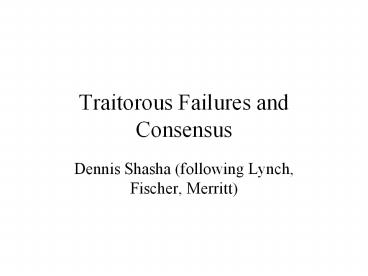Traitorous Failures and Consensus - PowerPoint PPT Presentation
1 / 11
Title:
Traitorous Failures and Consensus
Description:
The traitor knows the protocol and the inputs of the others. ... If all generals could get together in a single room, they could simply vote. ... – PowerPoint PPT presentation
Number of Views:16
Avg rating:3.0/5.0
Title: Traitorous Failures and Consensus
1
Traitorous Failures and Consensus
- Dennis Shasha (following Lynch, Fischer, Merritt)
2
Problem Statement 1
- Three generals A, B, and C.
- At most one is a traitor.
- The traitor knows the protocol and the inputs of
the others. - The generals must decide to attack or not to
attack (analogous to commit or abort).
3
Problem Statement 2
- Each day each general wakes up with an
inclination to attack or not to attack. - The generals then talk to one another by two way
phone. - So, A cannot overhear the conversation of B with
C and symmetrically.
4
Problem Statement 3
- If all generals wake up with an attack
inclination, the non-traitors should attack
(liveness 1) - If all generals wake up with a non-attack
inclination, the non-traitors should not attack
(liveness 2). - If some wake up wanting to attack and others not,
then either both non-traitors should attack or
both should not attack (safety).
5
What Makes this Hard
- If all generals could get together in a single
room, they could simply vote. - If two vote to attack then at least one
non-traitor wanted to attack, so attacking
accords with the rule. - If two vote not to attack then at least one
non-traitor didnt want to attack, so thats ok.
6
Communication Is Only Two Way
- If A is a traitor, then A could say one thing to
B and another thing to C. - B and C could later communicate, but they
wouldnt know whether the inconsistency came from
A or from one another.
7
Scenario 1
- All generals have an inclination to attack.
- However C is a traitor. What each general says is
in parentheses next to it. - C(no) (yes)A(yes) (yes)B(yes) (yes)C
- A and B should both say attack.
8
Scenario 2
- A has an inclination to attack. C does not and B
is the traitor. - C(no) (yes)A(yes) (yes)B(no) (no)C
- To A, the situation is as it was for Scenario 1,
so A attacks. C, in order to preserve safety,
must also attack.
9
Scenario 3
- Nobody has an inclination to attack. A is the
traitor - C(no) (yes)A(no) (no)B(no) (no)C
- To C, the situation is as it was in scenario 2,
so C attacks. But this violates our second
liveness condition.
10
Summary
- Even if you have only one traitor, two way
communication cannot guarantee a correct decision
among three generals. - Three way communication could have done so and so
could signed communication, because then no
general could have told inconsistent stories.
11
Postscript
- If I were two-faced, would I be wearing this
one? Abraham Lincoln































